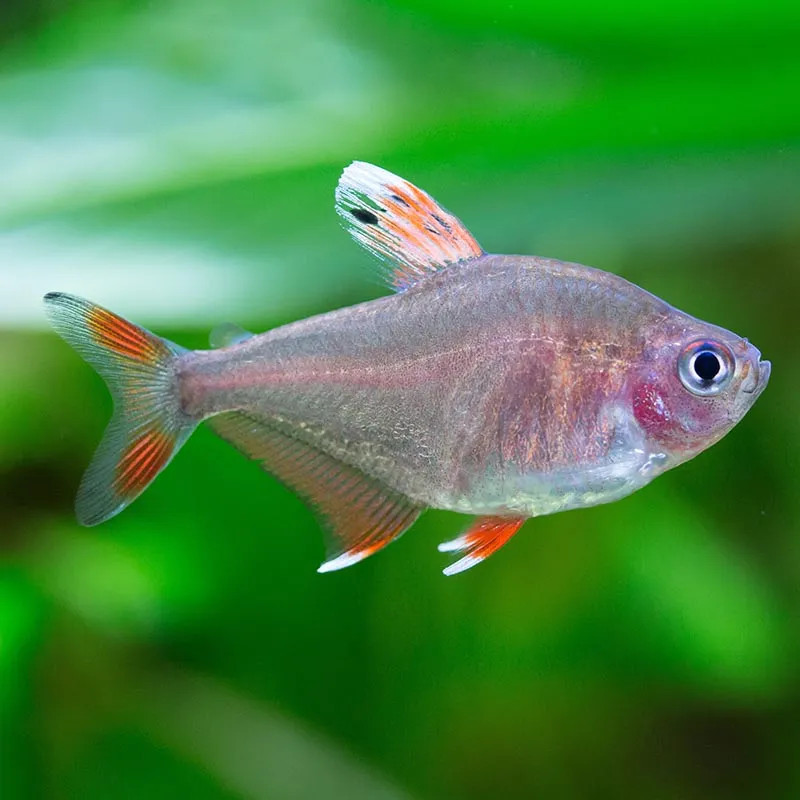Stocks Available
FW - Diamond Tetra
SKU:112471
MOENKHAUSIA PITTIERI
0.5-1.25 INCH

Stock Available
Introduction: Species: Hyphessobrycon bentosi Common Names: Candy Cane Tetra, Ornate Tetra, White Tip Tetra Natural Habitat: Native to slow-moving freshwater rivers and tributaries of the Amazon Basin in South America. These tetras thrive in densely vegetated areas with soft, acidic waters. Physical Characteristics: Appearance: The Candy Cane Tetra has a translucent, silvery body accented with striking red or pink markings, particularly around the fins. Their dorsal and anal fins are tipped with white, which, together with the red hues, gives them their "candy cane" nickname. Their bodies may also exhibit a subtle iridescence under aquarium lighting. Size: Grows up to 2 inches (5 cm) in length. Lifespan: Typically 3-5 years with proper care. Habitat Requirements: Tank Size: A minimum of 20 gallons is recommended for a group of 6 or more. Candy Cane Tetras are schooling fish and feel more comfortable and active when kept in larger groups. Water Conditions: Temperature: 73-82°F (23-28°C). pH: 5.5-7.5 (prefer slightly acidic to neutral water). Aquascaping: These tetras prefer a well-planted aquarium with a soft, sandy substrate and areas of subdued lighting. Include hiding spots using driftwood, rocks, and live plants like Java Fern or Amazon Sword to mimic their natural habitat. Diet: Primary Diet: Omnivorous; in the wild, they feed on small invertebrates, algae, and plant matter. Supplemental Feeding: In the aquarium, provide a varied diet of high-quality flakes or small pellets, supplemented with live or frozen foods such as bloodworms, brine shrimp, and daphnia. Feeding Frequency: Feed small amounts once or twice daily. Compatibility: Temperament: Candy Cane Tetras are peaceful and do well in a community tank. They are active swimmers and, when kept in a school, exhibit natural social behaviors. Suitable Tank Mates: Ideal tank mates include other small, peaceful species such as Neon Tetras, Corydoras, Harlequin Rasboras, and Dwarf Gouramis. Incompatibilities: Avoid housing them with aggressive or territorial species, as they may become stressed or fin-nipped. Care Level: Difficulty: Easy; Candy Cane Tetras are hardy and adaptable to a range of water conditions, making them suitable for beginner and experienced aquarists alike. Health Monitoring: Regular water changes and monitoring for common freshwater diseases like ich are important. They are generally resilient but can be affected by poor water quality. Breeding: Breeding in Captivity: Breeding Candy Cane Tetras is possible in home aquariums. Set up a separate breeding tank with soft, slightly acidic water, dim lighting, and fine-leaved plants or spawning mops for egg deposition. Spawning: They are egg scatterers, and the adults do not provide parental care. It's best to remove the adults after spawning to protect the eggs. Economic Considerations: Market Demand: Moderate demand due to their unique color and peaceful nature, making them popular in community tanks. Wholesale/Retail Pricing: Candy Cane Tetras are widely available and generally affordable. Sustainability and Conservation: Wild Population: Not currently considered at risk in the wild, although habitat destruction in the Amazon Basin could pose future threats. Aquaculture Efforts: They are commonly bred in captivity, which helps reduce pressure on wild populations. Regulations: Ensure compliance with local and international trade regulations when buying or selling these fish. Conclusion: The Candy Cane Tetra is a beautiful and peaceful addition to any community aquarium. Their striking red and white coloration, along with their active schooling behavior, makes them a favorite among aquarists. With proper care and attention to water quality and diet, these tetras can thrive, providing color and life to your freshwater setup.
Data sheet
15 other products in the same category:
Customers who bought this product also bought: